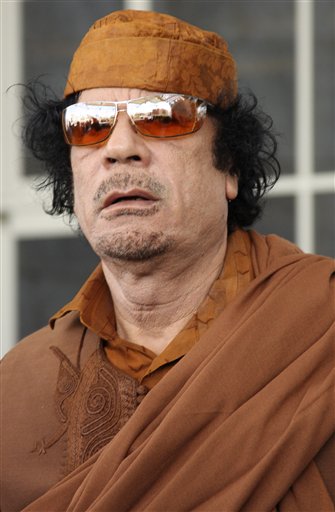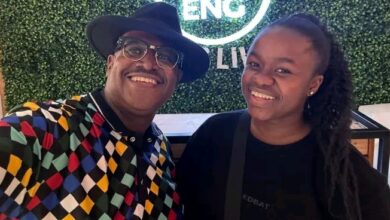30 Things you don’t know about Muammar Gaddafi

1. Real name Muammar Muhammad Abu Minyar al-Gaddafi
2. Muammar Gaddafi was born in a tent near Qasr Abu Hadi, a rural area outside the town of Sirte in the deserts of western Libya.
3. His family came from a small, relatively un-influential tribal group called the Qadhadhfa,who were Arabized Berber in heritage. His father, Mohammad Abdul Salam bin Hamed bin Mohammad, was known as Abu Meniar (died 1985), and his mother was named Aisha (died 1978); Abu Meniar earned a meagar subsistence as a goat and camel herder.
4. Muammar Gaddafi’s parents were illiterate and kept no birth records. As such, Gaddafi’s date of birth is not known with certainty, and sources have set it in 1942 or in the spring of 1943, although biographers Blundy and Lycett noted that it could have been pre-1940
5. Muammar Gaddafi’s parents’ only surviving son, he had three older sisters
6. Muammar Gaddafi ‘s upbringing in Bedouin culture influenced his personal tastes for the rest of the life. He repeatedly expressed a preference for the desert to the city, and retreated to the desert to meditate.
7. At the time of his birth, Libya was occupied by Italy, witnessing the conflict between Italian and British troops as a part of the North African Campaign of World War II. As a result, Gaddafi was aware of the involvement of European colonialists in his country from childhood.
8. According to later claims, Muammar Gaddafi’s paternal grandfather, Abdessalam Bouminyar, was killed by the Italian Army during the Italian invasion of 1911.
9. Muammar Gaddafi ‘s earliest education was of a religious nature, imparted by a local Islamic teacher.
10. From Sirte, he and his family moved to the market town of Sabha in Fezzan, south-central Libya, where his father worked as a caretaker for a tribal leader while Muammar attended secondary school, something neither parent had done.
11. Muammar Gaddafi moved to Misrata, there attending Misrata Secondary School. Maintaining his interest in Arab nationalist activism, he refused to join any of the banned political parties active in the city – including the Arab Nationalist Movement, the Arab Socialist Ba’ath Party, and the Muslim Brotherhood – claiming he rejected factionalism.
12. Briefly studying History at the University of Libya in Benghazi, Muammar Gaddafi dropped out to join the military. Despite his police record, in 1963 he began training at the Royal Military Academy, Benghazi, alongside several like-minded friends from Misrata.
13. With a group of loyal cadres, in 1964 Gaddafi founded the Central Committee of the Free Officers Movement, a revolutionary group named after Nasser’s Egyptian predecessor.
14. Graduating in August 1965, Muammar Gaddafi became a communications officer in the army’s signal corps. In April 1966, he was assigned to the United Kingdom for further training; over 9 months he underwent an English-language course at Beaconsfield, Buckinghamshire, a Royal Air Corps signal instructors course in Bovington Camp, Dorset, and an infantry signal instructors course at Hythe, Kent.
15. The 12 member central committee of the Free Officers proclaimed themselves the Revolutionary Command Council (RCC), the government of the new republic. Gaddafi became RCC Chairman, and therefore the de facto head of state, also appointing himself to the rank of Colonel and becoming commander-in-chief of the armed forces.
16. In June 1972 Gaddafi created the First Nasserite Volunteers Centre to train anti-Israeli guerrillas.
17. Muammar Gaddafi financially supported militant groups across the world, including the Black Panther Party, Nation of Islam, Tupamaros, 19th of April Movement and Sandinista National Liberation Front in the Americas, the ANC among other liberation movements in the fight against Apartheid in South Africa in Africa, the Provisional Irish Republican Army, Action directe, ETA, the Red Brigades, and the Red Army Faction in Europe, and the Armenian Secret Army, Japanese Red Army, Free Aceh Movement, and Moro National Liberation Front in Asia.
18. Seeking to diversify Libya’s economy, Gaddafi’s government began purchasing shares in major European corporations like Fiat as well as buying real estate in Malta and Italy, which would become a valuable source of income during the 1980s oil slump
19. With preceding legal institutions abolished, Gaddafi envisioned the Jamahiriya as following the Qur’an for legal guidance, adopting sharia law; he proclaimed “man-made” laws unnatural and dictatorial, only permitting God’s law. Within a year he was backtracking, announcing that sharia was inappropriate for the Jamahiriya because it guaranteed the protection of private property, contravening The Green Book’s socialism.
20. In 1989, the government founded the Al-Gaddafi International Prize for Human Rights, to be awarded to figures from the Third World who had struggled against colonialism and imperialism; the first year’s winner was South African anti-apartheid activist Nelson Mandela.
21. In October 2010, the EU paid Libya €50 million to stop African migrants passing into Europe; Gaddafi encouraged the move, saying that it was necessary to prevent the loss of European cultural identity to a new “Black Europe”.
22. In October 2010, Gaddafi apologized to African leaders on behalf of Arab nations for their involvement in the African slave trade.
23. A fundamental part of Gaddafi’s ideology was anti-Zionism. He believed that the state of Israel should not exist, and that any Arab compromise with the Israeli government was a betrayal of the Arab people.
24. Muammar Gaddafi was a very private individual, who described himself as a “simple revolutionary” and “pious Muslim” called upon by Allah to continue Nasser’s work.
25. Muammar Gaddafi saw himself as a fashion icon, stating “Whatever I wear becomes a fad. I wear a certain shirt and suddenly everyone is wearing it.”
26. Muammar Gaddafi was a fan of Beethoven, and said his favourite novels were Uncle Tom’s Cabin, Roots, and Colin Wilson’s The Outsider. He was also a soccer enthusiast.
27. Muammar Gaddafi married his first wife, Fatiha al-Nuri, in 1969. She was the daughter of General Khalid, a senior figure in King Idris’ administration, and was from a middle-class background. Although they had one son, Muhammad Gaddafi (b. 1970), their relationship was strained, and they divorced in 1970. Gaddafi’s second wife was Safia Farkash, née el-Brasai, a former nurse from Obeidat tribe born in Bayda. They met in 1969, following his ascension to power, when he was hospitalized with appendicitis; he claimed that it was love at first sight. The couple remained married until his death. Together they had seven biological children: Saif al-Islam Gaddafi (born 1972), Al-Saadi Gaddafi (b. 1973), Mutassim Gaddafi (1974–2011), Hannibal Muammar Gaddafi (b. 1975), Ayesha Gaddafi (b. 1976), Saif al-Arab Gaddafi (1982–2011), and Khamis Gaddafi (1983–2011?). He also adopted two children, Hanna Gaddafi and Milad Gaddafi.
28. Muammar Gaddafi claimed that he disliked this personality cult, but that he tolerated it because Libya’s people adored him
29. Muammar Gaddafi hired several Ukrainian nurses to care for him and his family’s health, and traveled everywhere with his trusted Ukrainian nurse Halyna Kolotnytska, a “voluptuous blonde”.
30. International reactions to Gaddafi’s death were divided. US President Barack Obama stated that it meant that “the shadow of tyranny over Libya has been lifted,” while UK Prime Minister David Cameron stated that he was “proud” of his country’s role in overthrowing “this brutal dictator”. Contrastingly, former Cuban President Fidel Castro commented that in defying the rebels, Gaddafi would “enter history as one of the great figures of the Arab nations” while Venezuelan President Hugo Chávez described him as “a great fighter, a revolutionary and a martyr.” Nelson Mandela expressed sadness at the news, praising Gaddafi for his anti-apartheid stance, remarking that he backed the African National Congress during “the darkest moments of our struggle”. Gaddafi was mourned by many as a hero across Sub-Saharan Africa, for instance, a vigil was held by Muslims in Sierra Leone. The Daily Times of Nigeria stated that while undeniably a dictator, Gaddafi was the most benevolent in a region that only knew dictatorship, and that he was “a great man that looked out for his people and made them the envy of all of Africa.”




